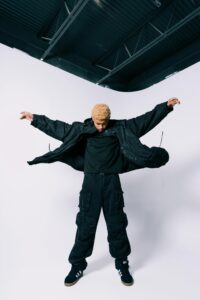So, cargo pants made me richer than I already was. Let’s talk about it.
Back in 1937, the world of workwear was dominated by long, simple overalls. Functional, yes, but far from fashionable or particularly versatile. They were the uniform of the working class, designed for durability but offering little in terms of style or innovation. It was a time ripe for change, a moment waiting for a revolution in utilitarian clothing.
Military Beginnings and Functional Design
The Birth of Cargo Pants in 1938
In 1938, amidst a world bracing for conflict, the British Army introduced a garment that would redefine military and workwear: cargo pants. Originally designed for paratroopers, these pants featured large pockets sewn onto the sides, providing easy access to maps, tools, and ammunition while on the move. The design was revolutionary, prioritizing functionality with its robust cotton fabric and secured closures to prevent loss of items during intense activity.
The initial reception among the military ranks was mixed. Traditionalists balked at the departure from standard uniform trousers, while forward-thinkers praised their practicality. Nevertheless, the utility of cargo pants soon became undeniable. They allowed soldiers to carry more, move faster, and adapt quickly to the dynamic demands of battlefield engagements.

As the war progressed, the adaptability of cargo pants saw them being adopted by various other military units, including engineers and tank crews. Their utility was proven in diverse environments, from European battlefields to Pacific islands, where the additional storage capacity significantly enhanced soldiers’ efficiency and readiness.
Transition to Civilian Adoption
Despite their success in military use, cargo pants did not immediately catch on in civilian life. Post-war, these pants were mostly seen on veterans who appreciated their durability and functionality for everyday tasks. However, slowly, outdoor enthusiasts began to recognize the value of cargo pants for activities that required carrying multiple items, like fishing, hunting, and hiking.
Post-War Evolution and Civilian Adoption
Cargo Pants Enter the Civilian Wardrobe
By the 1950s, cargo pants had begun a slow evolution from military surplus to mainstream fashion. Surplus stores became popular shopping destinations for rugged wear, where cargo pants were readily available and affordable. They appealed to a demographic looking for clothing that could withstand the rigors of not just outdoor activities but also the wear and tear of daily life.
This period marked the start of the functional clothing movement in civilian fashion, where practicality and durability started to merge with everyday style. Cargo pants, with their distinctive pockets and rugged appeal, were at the forefront of this trend. They were no longer just military gear but were becoming a symbol of adventurous, active lifestyles.
As cargo pants continued to spread across America and Europe, they began to shed their strictly utilitarian image. The 1960s and ’70s counter-culture movements embraced them for their practicality and as a symbol of rebellion against traditional fashion norms. This adoption by various subcultures laid the groundwork for cargo pants to enter the broader fashion conversation.
Transition to Fashion Mainstream
Though cargo pants were becoming more common in casual wear, it wasn’t until the fashion industry took notice in the late 20th century that their potential to transcend functional clothing fully emerged. As they entered the mainstream fashion world, cargo pants began to experience significant transformations in style, material, and perception, setting the stage for their elevation to a fashion staple.
From Function to Fashion
The Fashion Industry Takes Notice
The late 20th century marked a pivotal moment for cargo pants as designers began to recognize their potential beyond just utility. In the 1990s, as the world of fashion gravitated towards more casual, street-inspired looks, cargo pants found their way into the collections of innovative designers looking to merge functionality with fashion.
As ________, I saw an opportunity to redefine these practical garments. By the early 2000s, my designs began to incorporate cargo pants made with high-quality materials like silk blends and fine cotton, tailored to flatter rather than just to serve. The pockets, once purely functional, were stylized and proportioned to add aesthetic value without compromising their utility.

This period was characterized by experimentation with colors and prints, making cargo pants versatile enough to pair with luxury items like cashmere sweaters and leather jackets, propelling them into high fashion. Celebrities and style icons began to embrace this trend, wearing cargo pants on red carpets and in fashion magazines, further cementing their status as a fashionable choice.
The reimagined cargo pants appealed to a broad audience, from young urbanites to mature professionals seeking a blend of comfort and style in their wardrobes. This transformation was not just about changing perceptions of cargo pants but about challenging and expanding the definitions of modern attire.
Transition to Widespread Popularity
As cargo pants ascended the heights of fashion, their appeal broadened, reaching a global audience. This new wave of popularity was marked by their presence in every major fashion capital, from Paris to Tokyo, adapting to various cultural aesthetics and preferences.
Modern Fashion
Cargo Pants Achieve Icon Status
Entering the new millennium, cargo pants solidified their place as a versatile staple in the fashion industry. Designers continued to innovate, introducing variations that ranged from slim-fit to deconstructed styles, suitable for both high-end fashion shows and streetwear collections.
The adaptability of cargo pants made them a favorite among fashion-forward consumers. They were seen in a variety of settings, from music festivals and college campuses to boardrooms and chic cafes, each pair reflecting the personality and style of its wearer. The functionality of cargo pants, once designed for soldiers, had been fully embraced by the fashion world as both a practical and stylistic asset.

Collaborations between high-end designers and popular streetwear brands led to limited-edition cargo pants that sold out within hours of release. These collaborations were not only lucrative but also instrumental in keeping the cargo pants trend fresh and relevant.
Cultural Impact and Fashion Legacy
The enduring appeal of cargo pants can also be attributed to their cultural impact. They became more than just clothing; they were a statement of flexibility and readiness for the modern world’s challenges. Featured in blockbuster movies, worn by pop stars in music videos, and adopted by influencers in digital media, cargo pants transcended their military origins to become symbols of contemporary lifestyle.
The story of cargo pants is a testament to their ability to adapt to the times while maintaining their core attributes. They have been reinterpreted through the decades but have never strayed far from their roots, combining form and function in a way that few other garments can.
Impact and Legacy
The Lasting Influence of Cargo Pants
As we reflect on the evolution of cargo pants, their journey from rugged military wear to high-fashion staple exemplifies their transformative impact on both fashion and popular culture. This garment, once designed for the practical needs of soldiers, now caters to a global audience, continuously adapting to the shifting sands of style and functionality.
In the world of fashion, cargo pants have proven their staying power through their ability to reinvent themselves. Designers, including myself—Yves Saint Laurent, in this narrative—have played a pivotal role in this transformation. By integrating high-fashion elements with practical designs, we have helped elevate cargo pants from their humble beginnings to runway-worthy attire.
Cargo Pants in the Social Fabric
Beyond their aesthetic and functional appeal, cargo pants have woven themselves into the social fabric of various communities. They’ve been adopted by different subcultures and demographics, symbolizing everything from rebellion and freedom to sophistication and utility. Their versatility makes them a canvas for self-expression, allowing individuals to personalize their appearance while benefiting from their practicality.
A Symbol of Innovation
The story of cargo pants is also a story of innovation in the fashion industry. It demonstrates how traditional concepts can be transformed through creativity and strategic redesign. As fashion continues to evolve, cargo pants remind us that practical clothing does not have to be mundane. Instead, it can be dynamic, fashionable, and even luxurious.
If you hadn’t guessed by now, I would be Yves Satin Laurent, or more accurately those like him, who have brought light and popularity to this once “boring” pant.
Fashion played a pivotal role in transforming cargo pants from a practical military garment to a popular style staple, greatly profiting from their versatility and appeal. By the late 20th century, designers had begun reimagining cargo pants with various fabrics and cuts, integrating them into both high-fashion runways and streetwear collections. This adaptation broadened their appeal, attracting a diverse audience from outdoor enthusiasts to fashion-forward urbanites. The inclusion of cargo pants in major retail and luxury collections not only popularized them but also turned them into a profitable fashion trend, demonstrating how the industry could take a utilitarian item and make it a must-have accessory in wardrobes around the world.
Fashion’s Magic Touch: Turning Practical Wear into Must-Haves
Let’s dive into how fashion takes simple, everyday clothes and turns them into something special. Imagine it’s back in the day, and everyone’s wearing plain and practical clothes, just like those long overalls from 1937. They did the job, sure, but nobody would call them stylish.
When Designers Step In
Now picture this: fashion designers looking at those practical clothes and thinking, “We can make these cool.” They start playing around, swapping rough fabrics for something soft and comfy, cutting them in ways that make you look good. It’s like they’re giving a regular old jacket a superhero makeover.
Fashion Makes It Fun
What happens next? Well, people start seeing these new, snazzy versions on runway models and in store windows. Suddenly, everyone wants to wear them. It’s not just about clothes for work or getting through the day anymore. Now it’s about looking good and feeling good, all thanks to fashion.
Everyone Wants a Piece
This trend takes off, and it’s not just a few folks interested. We’re talking everyone, from young people hanging out to professionals in their fancy offices. The cool, revamped clothes are everywhere. Designers keep coming up with new twists, making sure there’s always something fresh that catches your eye.
Why It Matters
So, why do we care? Because fashion isn’t just about making us look good; it changes how we see clothes. It takes something ordinary and makes it extraordinary. And let’s not forget, this shift is big business. Turning practical wear into fashion statements opens up whole new opportunities for designers and stores to make a buck.
In the end, the fashion world keeps spinning because it knows how to take the everyday and make it exciting. That’s the power of style—it makes you want to wear it, live it, and love it.
If you’re interested in reading more, please check out:


